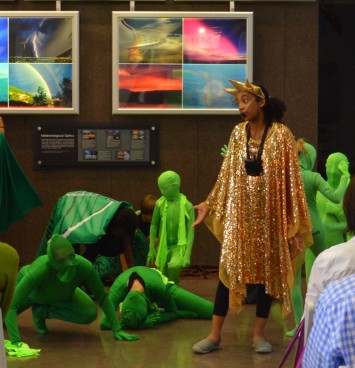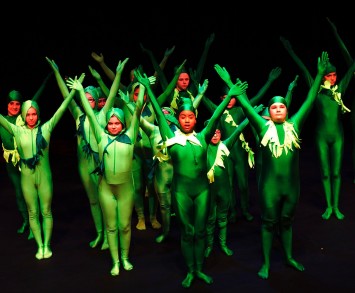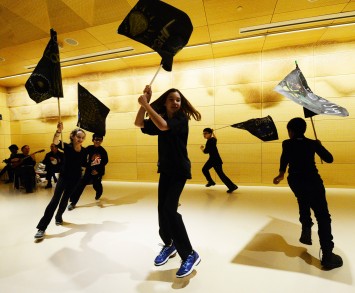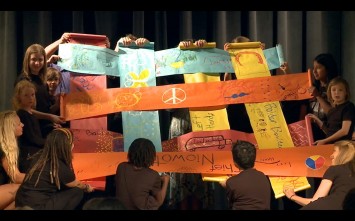Youth Shine in Musical Theatre for Sustainability
Table of Contents: February 2018 — Arts, Social Change, and a Vision for Sustainability
Osnes JSE Feb 2018 Arts Issue PDF
When I was in fourth grade, an environmentally concerned teacher taught my class this song, “Pollution, pollution, you can use the newest toothpaste, then rinse your mouth with industrial waste!” It was funny and catchy and decades later, I still remember the words, the tune, and the environmental lesson embedded in the song. In a similar spirit I created Shine, a mini-musical performance for 4th-12th grade students that uses theatre to explore issues of sustainability. It weaves climate science and artistic expression into a funny and powerful story that spans three hundred million years of geological time to convey the relationship between energy, humanity, and climate. Rehearsing each song in this half-hour musical immerses youth in the issues surrounding climate and energy and leads participants in embodying different aspects of climate science and human development that brought us to this point– where our use of fossil fuels is impacting our climate. The first half of the show is professionally scripted, composed, and choreographed to tell the story that has already been told by history. The second half—our future story– is made up of skits authored by local youth to generate solutions for their community’s sustainability challenges. A final song and dance celebrates this achievement and embeds the spirit of commitment into the catchy tune that students will be singing for perhaps decades to come.

Youth performing Shine at the National Center for Atmospheric Science in Boulder, Colorado.
Photo by Conner Callahan
Shine has been performed by local youth during its international tour from 2015 to 2017 in New York City, London, New Orleans, Boulder, Chicago, the Navajo Nation, and Malope, South Africa. As an Associate Professor of Theatre and Environmental Studies at the University of Colorado, I wrote and created this performance experience in collaboration with nationally recognized performing artists and climate scientists. Three-time Grammy winner, Tom Wasinger composed the music, and master teacher with the New York City National Dance Institute and former Broadway performer, Arthur Fredric, developed the choreography. Primary scientific collaborators included Paty Romero Lankeo with the National Center for Atmospheric Research and Joshua Sperling with the National Renewable Energy Laboratory.
This article is an open invitation to educators and youth organizers to use Shine and its accompanying support materials to actively engage youth in their schools and organizations on issues of sustainability. Teachers have open access to the script, music, choreography, curriculum materials, and more for Shine via its accompanying website http://www.insidethegreenhouse.org/shine. The book Performance for Resilience: Engaging Youth on Energy and Climate through Music, Movement, and Theatre(Osnes 2017) was recently published that shares the story of the international tour of Shine and the lessons learned and recommendations from mounting the production with local youth in each host community. These materials will be useful for educators who seek active methods for engagement in issues related to energy, climate, resilience, and sustainability. Included in the website and book are ideas for youth engagement, ranging from hour-long modules, to a multi-week mounting of a production. Please feel free to contact beth.osnes@colorado.edu with any questions or for consultations.
There are multiple levels of possible engagement with Shine. If time and resources are limited, educators and community organizers may want to show their students the video of the full performance of Shine (http://www.insidethegreenhouse.org/shine/), and merely engage youth in conversation about issues introduced in the show—utilizing the following discussion questions.
- Science-based questions
- How do plants and animals leave behind fossils?
- How do plants get their energy to grow?
- How do you think “fossil fuels” got that name?
- What are some of the characteristics of communal-based agricultural practices? How does the introduction of fossil fuels change these?
- What is the carbon cycle? How can it be “disrupted”, as discussed in the show?
- Literature-based questions
- Why is “Foss” considered the brother of “Sol”?
- What does Sol think of carbon emissions at the beginning of Shine? How does her perspective change throughout the script?
- How do the “Foss Followers” feel about the Harvesters and their lifestyle and vice
- versa?
- Why does Foss’s idea for progress make Sol so concerned?
- How is metaphor used in this play? Is this an example of literary metaphor or dramatic metaphor?
- What is the effect of having anthropomorphized characters? How does this impact your understanding of the scientific concepts presented?
If more time is available, Act One of the full performance can be shown, and teachers can use the Act 2 module to guide students in creating skits for their own Act Two, finding solutions to climate, energy, and resilience challenges that they identify from their own community. Alternately, any modules described in Chapter 2 in the book (or available online using the “Engaging Students” tab at http://www.insidethegreenhouse.org/shine) can be used and contextualized by viewing the video of the full production. Various parts of the performance can be used independently to address specific areas of study or concern. For example, an educator may want to engage her class in staging the Harvest module to actively explore differences between urban and rural lifestyles and values in regard to agriculture and energy. The resilience or sustainability focus of your community may be different than the focus of Shine, which is climate and energy. In that case, you may want to use Shine as an example for how performance can be a useful tool for exploring issues vital to your community and create a new performance piece entirely.
Material in this book and its accompanying website can easily be used towards a standards-based curriculum. This project provides materials for easily creating a curriculum module that can be utilized to reach Common Core standards by teachers of English language arts/literacy (ELA) or for Next Generation Science Standards (NGSS) or state science standards. The learning goals for youth participants of Shine include:
Subject Area Learning Goals:
- understanding the relationship between energy and climate (Science)
- placing the earth’s production of fossil fuels and the impact of human-use of fossil fuels into scale within the last 300,000,000 years of geological history (Geology)
- understanding how our energy-use is impacting climate (Science)
- placing all this within the context of human history and society (Sociology, History, Civics)
- understanding effective climate communication by critically engaging with the script for Act One, and by inviting youth to author Act Two, dramatizing local solutions towards a positive climate future (English, Media, Science, Civics)
Participatory Performance Learning Goals:
- embodied learning
- nuanced understanding of themes through physical participation in dramatic metaphors
- youth empowerment
- civic engagement
- collaboration with others to effectively communicate youth-authored solutions to an audience
- students as authors of knowledge and partners in public display
In multiple locations of the tour of Shine, the production was mounted in a day with a trained facilitator, and in other locations, during a week-long residency. The process of students engaging with the material in an embodied and participatory way is as much the goal as the resulting production at the culmination. Nearly all the speaking in Shine is done by Sol (the Sun) and Foss (her younger brother, fossil fuels), with the rest of the cast as the ensemble bringing to life what is being spoken about. The spoken portions of the show can be previously rehearsed or read aloud from a script. There are five songs in the show that each include some form of movement and include the use of artistic properties created mostly by the youth. Four of the songs each have pre-established simple, accessible, but artistically beautiful choreography that can be viewed on the website. Recordings of each of the songs, both with and without the lyrics, are available on the website as well. Even if using the recordings with the lyrics sung, youth should be encouraged to sing along. For the final title song Shine, the group should choreograph their own movement themselves to support greater self-expression by the cast. Time should also be set aside to allow youth participants to decorate the properties we need for the show, such as the eight colorful paper strands decorated to represent their city (that will be woven into the fabric of community by the harvesters) and the five flags bearing images of how their city utilizes fossil fuels (flags that will be held by the people representing the excessive use of fossil fuels that will rip through the fabric of community during a storm brought on by climate change at the culmination of Act 1). Each experience, the making of the properties, the songs, the script, and the movement, is all designed to deepen their understanding of the issues of climate, energy, and sustainability.
The over-arching goal of this project is to create a performance experience for youth that guides them through an embodied exploration of the climate legacy they have inherited. Shine further works to inspire and equip youth to create local solutions for inclusion in their city’s plan for resilience. One of the objectives for achieving this goal is to have youth immersed in artistic excellence and the preeminent science on climate and energy, through the process of rehearsing Act One, authoring Act Two, and performing the show before their larger community. What we do in these coming decades will determine if we can thrive or even survive on this planet as a species. Shine rouses a sleeping giant—youth—to joyfully engage in authoring a brighter and more sustainable story for our future.
References:
Osnes, Beth. 2017. Performance for Resilience: Engaging Youth on Energy and Climate through Music, Movement, and Theatre. Palgrave Pivot. Cham, Switzerland: Springer International Publishing.













 Beth Osnes is an applied theatre practitioner, a theatre scholar, and a solo performer.
Beth Osnes is an applied theatre practitioner, a theatre scholar, and a solo performer. 
